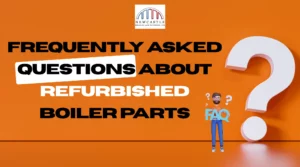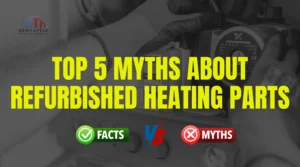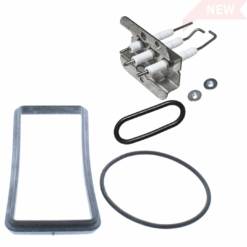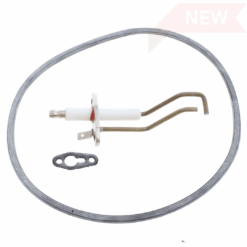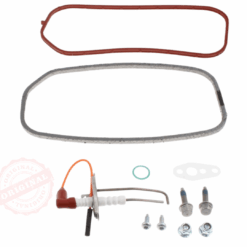Ideal Logic L1 Fault Code – What It Means and How to Fix It
Estimated reading time: 6 minutes
The Ideal Logic L1 fault code indicates a problem with water flow or temperature. It usually occurs when water inside the boiler overheats or can’t circulate properly. Causes include a faulty pump, a broken thermistor, limescale build-up, or issues with the PCB. While some problems can be fixed with a reset, others require attention from a qualified Gas Safe engineer. This guide explains what the L1 error means, how to fix it, and how to prevent it from happening again.

Table of contents
What Does Ideal Logic L1 Fault Code Mean?
The L1 fault means the water inside your boiler is either too hot or not flowing correctly. To protect internal components, the boiler locks out and stops heating. This prevents further damage and ensures safety.
Sometimes, this fault occurs because the flow thermistor has failed and is sending the wrong temperature readings. In other cases, overheating happens because hot water can’t circulate due to pump failure or internal blockages. Poor water flow can cause rapid heat build-up, which the boiler detects as a fault.
Common Causes of the Ideal Logic L1 Fault Code
Several faults can trigger the Ideal Logic L1 fault code. Here are the most common ones:
1. Faulty Flow Thermistor
The thermistor measures water temperature as it flows through the boiler. If it’s damaged or faulty, the boiler may shut down to avoid overheating – even if the water is at a normal temperature.
2. Limescale or Sludge Build-up
In hard water areas, limescale builds up inside the heat exchanger and pipes. This reduces water flow, making the system overheat. Sludge build-up in radiators and pipework can have a similar effect.
3. Broken or Stuck Heating Pump
The pump moves hot water around your central heating system. If it’s stuck or has failed, water will remain inside the boiler, rapidly heating up until the L1 fault is triggered.
4. Faulty PCB (Printed Circuit Board)
The PCB controls your boiler’s functions. If it can’t read temperature inputs correctly or fails to respond, it may cause incorrect shutdowns or misinterpret the water temperature.
How to Fix the Ideal Logic L1 Error Code
Time needed: 5 minutes
Follow these step-by-step checks to help identify and resolve the L1 fault code on your Ideal Logic boiler.
- Check Water Pressure
Check the pressure gauge on your boiler. It should read between 1.0 and 1.5 bar. If it’s low, top it up using the filling loop. If pressure keeps dropping, there may be a leak.
- Reset the Boiler
Find the reset button on the boiler’s control panel. Press and hold it for 3–5 seconds. If the boiler restarts and works normally, the problem might have been temporary. If the fault returns, move to the next steps.
- Inspect for Blockages or Scale
Look at your system’s pipework and radiators. Cold spots or strange sounds may indicate blockages or sludge. In older systems or hard water areas, limescale inside the boiler could also reduce water flow. A system flush may be required.
- Check the Flow Thermistor
If the sensor that measures water temperature is damaged, the boiler may shut down as a safety precaution. A Gas Safe engineer can test and replace the thermistor if needed.
- Assess the Pump
Listen to the boiler during operation. If the pump is silent or making irregular noises, it could be seized or broken. This will cause overheating. Only a qualified engineer should inspect or replace the pump.
- Test the PCB
If all other components are working but the error persists, the issue might be with the PCB. This component controls boiler functions and reads sensor data. Faulty PCBs must be diagnosed and replaced by a professional.
When to Call a Gas Safe Engineer
If resetting the boiler doesn’t solve the problem or if the L1 fault keeps coming back, it’s time to call a Gas Safe registered engineer. You should also call an expert if your heating doesn’t work, the pump is silent, or you suspect limescale build-up. Never try to dismantle or fix internal boiler parts yourself—this should always be left to qualified professionals.
How to Prevent the L1 Fault Code in Future
Preventing the L1 fault code comes down to proper maintenance. Start with an annual boiler service carried out by a Gas Safe engineer. During servicing, engineers can clean the system, inspect components, and check the water pressure.
Using a heating system inhibitor helps reduce limescale and sludge build-up. In areas with hard water, consider fitting a magnetic filter to trap debris. Always keep an eye on pressure levels and ensure they stay between 1.0 and 1.5 bar. These steps can keep your boiler efficient and reduce the chance of future faults.
Conclusion
The Ideal Logic L1 fault code is caused by water overheating or poor flow inside the boiler. Common reasons include a faulty thermistor, broken pump, or limescale build-up. A quick reset might fix it, but repeated faults usually mean a deeper issue that needs professional attention. Regular servicing and water treatment can help prevent future problems and keep your boiler running efficiently.
Frequently Asked Questions
It means the boiler has detected that the water is either too hot or not circulating properly and has shut down to prevent damage.
You can check the water pressure, reset the boiler, and look for signs of blockage. But anything beyond that should be handled by a Gas Safe engineer.
While the lockout is a safety measure, the underlying issue—like overheating or a broken pump—needs to be addressed quickly to avoid further damage.
Costs vary based on the cause. Replacing a sensor is fairly low-cost, but pump or PCB issues may be more expensive. Always get a quote from a qualified engineer.
Book yearly servicing, use an inhibitor, install a magnetic filter, and regularly check your boiler’s pressure. These steps will reduce the risk of overheating and improve system performance.
The Ideal Logic F2 Fault Code indicates flame loss during operation. It means the boiler lit a flame but couldn’t keep it going. This triggers a safety lockout. Causes include gas supply issues, ignition faults, or blocked flue pipes.


